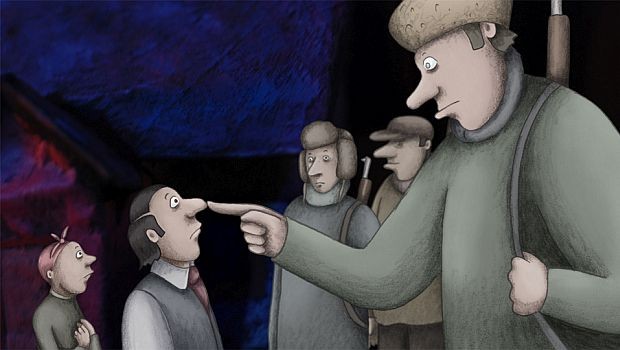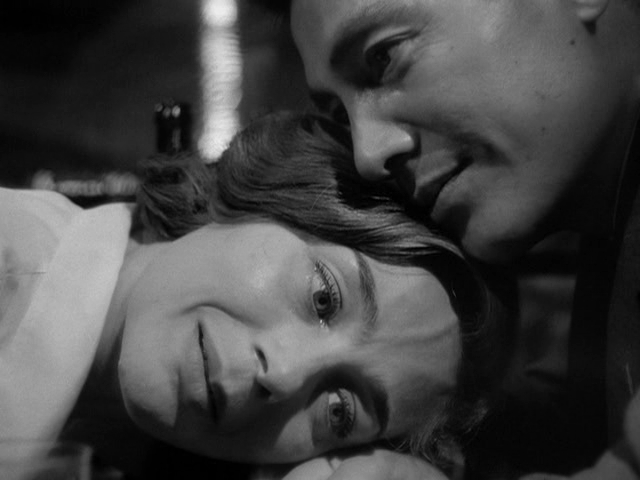
A French actress (Emmanuelle Riva) and a Japanese architect (Eiji Okada) examine their Hiroshima affair in Alain Resnais classic
HIROSHIMA MON AMOUR (Alain Resnais, 1959)
Film Society of Lincoln Center, Elinor Bunin Munroe Film Center, 144 West 65th St., October 17-30, 212-875-5050
Film Forum, 209 West Houston St., October 17-28, 212-727-8110
www.filmforum.org
www.filmlinc.com
 In July 1959, Cahiers du cinéma published a roundtable discussion with Eric Rohmer, Jean-Luc Godard, Jacques Rivette, and others about Alain Resnais’s Hiroshima Mon Amour, in which Rohmer said, “Hiroshima is a film about which you can say everything. . . . Perhaps Hiroshima really is a totally new film. . . . I think that, in a few years, in ten, twenty, or thirty years, we shall know whether Hiroshima was the most important film since the war, the first modern film of sound cinema. . . . In any case it is an extremely important film, but it could be that it will even gain stature with years.” Some four and a half decades later, Rohmer’s prediction has come true, as a stunning new 4K digital restoration reveals Hiroshima Mon Amour to indeed be one of the most important films in the history of cinema, redefining just what the medium is capable of, as fresh and innovative today as it was to Rohmer, Godard, Rivette, et al. upon its initial release. As the black-and-white film opens, two naked, twisted bodies merge together in bed, first covered in glittering ashes, then a kind of acid rain. The woman (Emmanuelle Riva) is a French actress who is in Hiroshima to make a movie about peace. He (Eiji Okada) is a Japanese architect, a builder working in a city that has been laid to waste. Both married with children, they engage in a brief but torrid affair; as her film prepares to wrap, she gets ready to leave, but he begs her to stay. Theirs is a romance that could happen only in Hiroshima.
In July 1959, Cahiers du cinéma published a roundtable discussion with Eric Rohmer, Jean-Luc Godard, Jacques Rivette, and others about Alain Resnais’s Hiroshima Mon Amour, in which Rohmer said, “Hiroshima is a film about which you can say everything. . . . Perhaps Hiroshima really is a totally new film. . . . I think that, in a few years, in ten, twenty, or thirty years, we shall know whether Hiroshima was the most important film since the war, the first modern film of sound cinema. . . . In any case it is an extremely important film, but it could be that it will even gain stature with years.” Some four and a half decades later, Rohmer’s prediction has come true, as a stunning new 4K digital restoration reveals Hiroshima Mon Amour to indeed be one of the most important films in the history of cinema, redefining just what the medium is capable of, as fresh and innovative today as it was to Rohmer, Godard, Rivette, et al. upon its initial release. As the black-and-white film opens, two naked, twisted bodies merge together in bed, first covered in glittering ashes, then a kind of acid rain. The woman (Emmanuelle Riva) is a French actress who is in Hiroshima to make a movie about peace. He (Eiji Okada) is a Japanese architect, a builder working in a city that has been laid to waste. Both married with children, they engage in a brief but torrid affair; as her film prepares to wrap, she gets ready to leave, but he begs her to stay. Theirs is a romance that could happen only in Hiroshima.
Director Alain Resnais (Last Year at Marienbad, Same Old Song) was meticulous with every detail of the film, from the casting to Marguerite Duras’s stirringly poetic, Oscar-nominated script and dialogue, from Georges Delerue’s and Giovanni Fusco’s powerful, wide-ranging score to crafting each shot as a work of art in itself, using two cinematographers, Michio Takahashi in Japan and Sacha Vierny in France, to emphasize a critical visual difference between the contemporary scenes in Hiroshima and the woman’s past with a German soldier (Bernard Fresson) in Nevers. Hiroshima Mon Amour is a haunting experience, examining love and loss among the ruins of war as two people, at least temporarily, try to create something new. Riva (Three Colors: Blue, Thomas the Impostor) is mesmerizing as the confused, unpredictable woman, her eyes so often turned away from the man, unwilling to face the future, while Okada (Woman in the Dunes, The Yakuza) can’t keep his eyes off her, desperate for their romance to continue. Riva bookended her long career by starring in two of the most unusual yet beautiful love stories ever made, as more than fifty years after Hiroshima she would be nominated for an Oscar for her hypnotizing performance as an elderly woman debilitated by a stroke in Michael Haneke’s Amour. The glorious restoration of Hiroshima Mon Amour,, supervised by Renato Berta, who was Resnais’s chief cameraman on four projects, makes it, to use the words of Eric Rohmer, feel like a totally new film, like we’re experiencing it for the very first time all over again. Following its sold-out screening at the New York Film Festival, Hiroshima Mon Amour opens October 17 at Film Forum and the Elinor Bunin Munroe Film Center. Resnais, who passed away on March 1 at the age of ninety-one, was also represented at the festival with his final work, Life of Riley. In conjunction with the theatrical release of the restoration, the Film Society of Lincoln Center will also host the series “By Marguerite Duras” October 15-22.
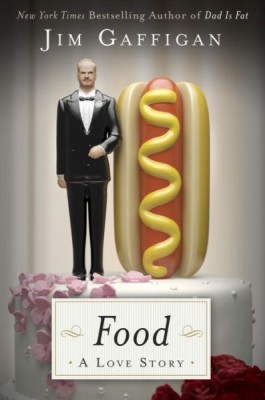
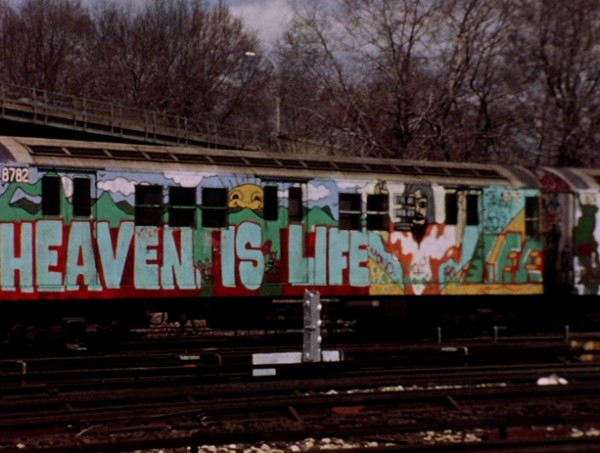
 Thirty-three years after screening at the New York Film Festival, Manfred Kirchheimer’s Stations of the Elevated is finally getting its official U.S. theatrical release, in a gorgeous new restoration showing at BAMcinématek October 17-23. In 1977, Manfred Kirchheimer, whose family escaped Nazi Germany in 1936, went to the Bronx and filmed graffiti-covered subway cars at the train depot and rushing across the elevated tracks, kids playing in a burned-out housing project, and giant billboards advertising hamburgers, cigarettes, alcohol, and suntan lotion. Shot on 16mm reversal stock, Stations of the Elevated is more than just a captivating document of a bygone era; it is a deeply poetic socioeconomic journey into class, race, art, and freedom of expression, told without a single word of narration or onscreen text. Instead, producer, director, editor, and photographer Kirchheimer (Colossus on the River, Bridge High with Walter Hess) shifts from the natural sound of the environment to a superb jazz score by Charles Mingus while cutting between shots of trains covered in tags and illustrations (and such phrases as “Heaven Is Life,” “Invasion of the Earth,” “Never Die,” and “Earth Is Hell”) by such seminal figures as Blade, Daze, Lee, Pusher, Shadow, and Slave and views of colorful billboards filmed peeking through the geometric architecture of the elevated railways and set against bright blue skies. Most often, the camera focuses on the painted eyes in the ads, looking right back at the viewer as they dominate the scene, evoking the optician’s ad in that famous novel of American class, The Great Gatsby. (The concentration on the eyes also predicts how Madison Ave. was watching the graffiti movement, eventually coopting the imagery into mainstream advertising.) Through this dichotomy of meaning and execution, Kirchheimer reveals similarities in artistic styles and how the elements influenced each other; a particularly telling moment occurs when a man is shown hand painting a billboard who could have just as well been spray painting a subway car.
Thirty-three years after screening at the New York Film Festival, Manfred Kirchheimer’s Stations of the Elevated is finally getting its official U.S. theatrical release, in a gorgeous new restoration showing at BAMcinématek October 17-23. In 1977, Manfred Kirchheimer, whose family escaped Nazi Germany in 1936, went to the Bronx and filmed graffiti-covered subway cars at the train depot and rushing across the elevated tracks, kids playing in a burned-out housing project, and giant billboards advertising hamburgers, cigarettes, alcohol, and suntan lotion. Shot on 16mm reversal stock, Stations of the Elevated is more than just a captivating document of a bygone era; it is a deeply poetic socioeconomic journey into class, race, art, and freedom of expression, told without a single word of narration or onscreen text. Instead, producer, director, editor, and photographer Kirchheimer (Colossus on the River, Bridge High with Walter Hess) shifts from the natural sound of the environment to a superb jazz score by Charles Mingus while cutting between shots of trains covered in tags and illustrations (and such phrases as “Heaven Is Life,” “Invasion of the Earth,” “Never Die,” and “Earth Is Hell”) by such seminal figures as Blade, Daze, Lee, Pusher, Shadow, and Slave and views of colorful billboards filmed peeking through the geometric architecture of the elevated railways and set against bright blue skies. Most often, the camera focuses on the painted eyes in the ads, looking right back at the viewer as they dominate the scene, evoking the optician’s ad in that famous novel of American class, The Great Gatsby. (The concentration on the eyes also predicts how Madison Ave. was watching the graffiti movement, eventually coopting the imagery into mainstream advertising.) Through this dichotomy of meaning and execution, Kirchheimer reveals similarities in artistic styles and how the elements influenced each other; a particularly telling moment occurs when a man is shown hand painting a billboard who could have just as well been spray painting a subway car. 
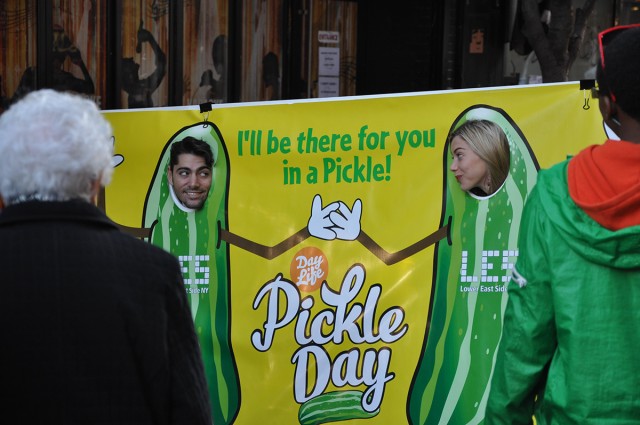

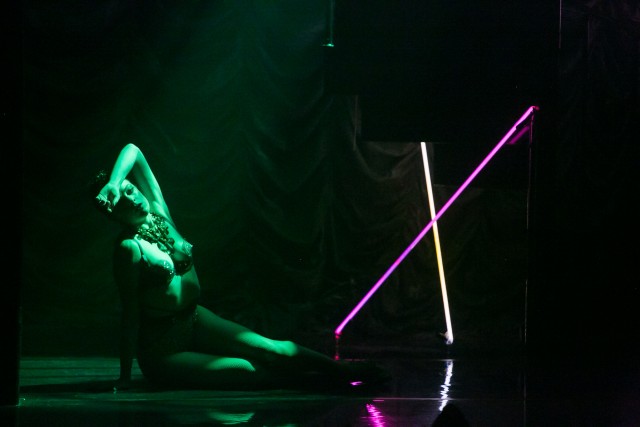
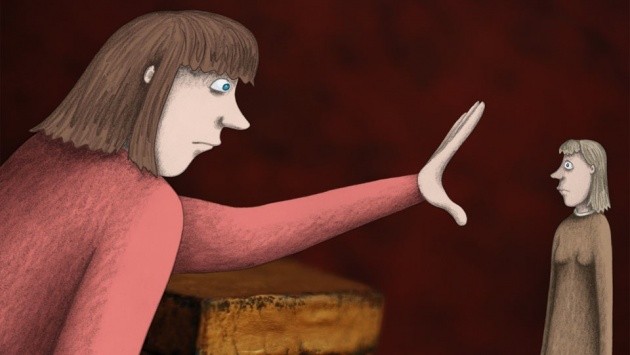
 The recent suicide of Robin Williams shook the nation, once again pointing out that depression is no laughing matter. But Latvian-born, Brooklyn-based writer-director-producer-animator Signe Baumane takes a unique approach to depression and suicide in the darkly twisted animated film Rocks in My Pockets: A Crazy Quest for Sanity. Influenced by such animation giants as Jan Švankmajer and Bill Plympton in addition to Lithuanian-Polish illustrator Stasys Eidrigevicius and Russian animator Yuri Norstein, Baumane, a self-described “Master of Self Pity,” incorporates hand-drawn animation, papier-mâché constructions, and stop-motion animation in telling the story of her family’s long history of mental illness and suicide. Inspired by her own thoughts of ending it all, Baumane (Teat Beat of Sex), in her feature-length debut, divides the film into segments about her suicidal relatives. She narrates the tales of Indulis, an entrepreneur and failed counterfeiter with an “idea-generating brain”; Anna, a university graduate and secretary who falls in love with Indulis, her married boss; Miranda, who looks at the world as if everything were a work of art; Linda, a medical student with big dreams; Irbe, a lonely music teacher who hears voices in her head; and herself as they all experience various aspects of severe depression while facing the trials and tribulations of everyday life in a changing sociopolitical climate in Eastern Europe.
The recent suicide of Robin Williams shook the nation, once again pointing out that depression is no laughing matter. But Latvian-born, Brooklyn-based writer-director-producer-animator Signe Baumane takes a unique approach to depression and suicide in the darkly twisted animated film Rocks in My Pockets: A Crazy Quest for Sanity. Influenced by such animation giants as Jan Švankmajer and Bill Plympton in addition to Lithuanian-Polish illustrator Stasys Eidrigevicius and Russian animator Yuri Norstein, Baumane, a self-described “Master of Self Pity,” incorporates hand-drawn animation, papier-mâché constructions, and stop-motion animation in telling the story of her family’s long history of mental illness and suicide. Inspired by her own thoughts of ending it all, Baumane (Teat Beat of Sex), in her feature-length debut, divides the film into segments about her suicidal relatives. She narrates the tales of Indulis, an entrepreneur and failed counterfeiter with an “idea-generating brain”; Anna, a university graduate and secretary who falls in love with Indulis, her married boss; Miranda, who looks at the world as if everything were a work of art; Linda, a medical student with big dreams; Irbe, a lonely music teacher who hears voices in her head; and herself as they all experience various aspects of severe depression while facing the trials and tribulations of everyday life in a changing sociopolitical climate in Eastern Europe. 